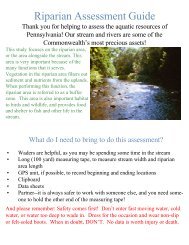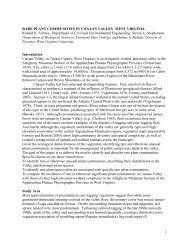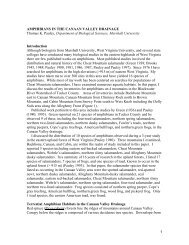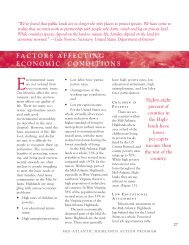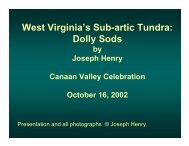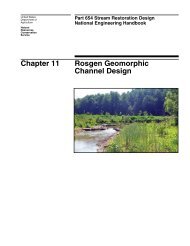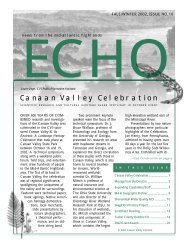1 PREHISTORY OF CANAAN VALLEY: AN ECOLOGICAL VIEW ...
1 PREHISTORY OF CANAAN VALLEY: AN ECOLOGICAL VIEW ...
1 PREHISTORY OF CANAAN VALLEY: AN ECOLOGICAL VIEW ...
You also want an ePaper? Increase the reach of your titles
YUMPU automatically turns print PDFs into web optimized ePapers that Google loves.
The ultimate currency for measuring optimal solutions is the number of offspring<br />
that in turn reproduce (Alcock 1984). In a more proximal sense, benefits can be measured<br />
in net gains of matter and energy, and costs can be measured in losses to predators, travel<br />
time not available for other tasks, and the load weight (Krebs and Davies 1987).<br />
Assuming prehistoric people in the Mid-Atlantic highlands gathered food optimally<br />
(sensu Dunham 1996); village-based hunting-gathering may have taken the form of<br />
central-place foraging. In this kind of space use, food is acquired distantly and loads are<br />
returned to a central site (Wetterer 1989). According to the central-place foraging model,<br />
when travel time is shorter, the load that maximizes profit is smaller; conversely load size<br />
should increase with distance (Krebs and Davies 1987). Prehistoric people would not<br />
have hiked from Horseshoe Bend to Canaan Valley for a pouch of snowshoe hares; they<br />
intended to haul out large packages of energy, e.g., carcasses.<br />
It is appropriate that a Woodland contemporary, the beaver, conforms to some<br />
predictions of central-place foraging theory. Beavers cut a smaller range of tree sizes<br />
(i.e., are increasingly selective) farther from their ponds (Jenkins 1980, Fryxell and<br />
Doucet 1991).<br />
The hypotheses of annual migration and central-place foraging are not mutually<br />
exclusive. It is possible that migrants moved through a series of extended-stay camps,<br />
from which central-place foraging was conducted daily.<br />
This leads me to summarize a general ecological theory of prehistoric peoples' use<br />
of Canaan Valley. Most people most of the time lived in the optimal habitats of major<br />
river valleys. Because it was sub-optimal habitat, they only occasionally visited Canaan<br />
Valley. When they did use the Valley, it was as a stop along an annual migration and/or<br />
for central-place hunting of large-bodied game. Proximal reasons for low visitation<br />
included behavioral avoidance and long distances from population centers.<br />
Specific hypotheses<br />
The general model suggests 15 testable hypotheses. Under either the migration or centralplace<br />
scenario, Canaan Valley:<br />
1. offered only a few kinds or low densities of valued resources;<br />
2. started to be used after optimal habitats (e.g., river valleys) were taken;<br />
3. will yield no artifacts of long-term occupation, e.g., permanent dwellings,<br />
gardens; and<br />
4. was used during the most optimal times of the year, e.g., early summer.<br />
Although annual migration and central-place foraging may be complementary, each<br />
behavior generates the following hypotheses that could allow rejection of either scenario.<br />
The former implies longer (e.g., 1-2 months) stays than the latter (e.g., 1-2 days).<br />
Annual migration – Canaan Valley:<br />
5. was used for many days (e.g., 30-60) at the same season each year;<br />
6. will yield toolkits composed of some heavy items;<br />
7. will reveal repeated-use hearths; and<br />
8. provided diverse, but low-density plant and animal foods.<br />
11





